When I was a kid growing up in the Midwest, each November my American friends would ask me why I was wearing a red flower on my coat. Canadians pretty much blend right in south of the 49th parallel, given enough time, but you can sometimes pick them out by looking for a few weird habits, like celebrating Thanksgiving a month and a half early, and like wearing plastic poppies in early November.
I don’t know how my mom got the authentic plastic given-out-by-Canadian-veterans-in-malls poppies down there. I imagine she saved them from before she moved away. But for those Canadian ex-pats less outrageously forward-planning, or Canadians (ex-pats or not) who keep having the darn things come unpinned and make a leap for freedom whenever their purse shifts slightly, here is a very simple, very quick tutorial for making your own Remembrance Day poppies.
For those non-Canadians wondering, as my school friends did, what the heck I’m talking about, the poppies represent Canadian soldiers who died in the World Wars, hence their significance for Remembrance Day. The reference goes back to a poem titled Flanders Fields, and attributed to John McCrae. Many World War I soldiers lie in unmarked graves in the region of Flanders, Belgium, where a great deal of fighting took place. For some time after the fighting, red poppies grew profusely on the battlefields, due to the soil becoming rich in poppy-growing nutrients from all the war-zone rubble. Every Canadian child (even I, who grew up in the States) memorized this poem at some point during their school years.
In Flanders fields the poppies blow
Between the crosses, row on row,
That mark our place; and in the sky
The larks, still bravely singing, fly
Scarce heard amid the guns below.
We are the Dead. Short days ago
We lived, felt dawn, saw sunset glow,
Loved and were loved, and now we lie,
In Flanders fields.
Take up our quarrel with the foe:
To you from failing hands we throw
The torch; be yours to hold it high.
If ye break faith with us who die
We shall not sleep, though poppies grow
In Flanders fields.
– John McCrae
What you’ll need:
- red felt
- black felt
- red thread
- black thread
- scissors
- a sewing needle
- straight pins
- a clasp pin backing or safety pin
- [optional] black beads
- poppy template (or you can draw your own)
Putting it all together:
1) Trace and cut out your shapes. (Or pin the templates to the felt and cut around them.) One larger flower and one smaller flower from the red felt, and a small circle-with-scalloped-edges from the black felt.
2) Sew the black circle to the small red flower, using stitches of varying lengths that go well into the red area.
3) [optional] If desired, sew small black beads overtop of the black felt. I double stitched mine in place to make sure they stayed put.
4) Using your red thread now, take the larger red flower and sew a rough circle of large stitches around its centre.
5) Before knotting the thread, pull on it a bit so the felt flower puckers and gathers in the middle. This gives your poppy some shape, rather than just letting it sit flat against your coat.
6) Still using red thread, the small flower to the larger flower. Stitch right around the edge of the poppy’s black centre, so that the red stitching is pretty much invisible on the front.
7) Stitch your pin backing or a large safety pin to the back of the flower.
8) Pin to your coat and wear outside. They really do stand out nicely, eh? Just make sure you’ve memorized the poem so you can thoroughly explain to quizzical non-Canadians just why the heck you’re wearing a poppy in November.

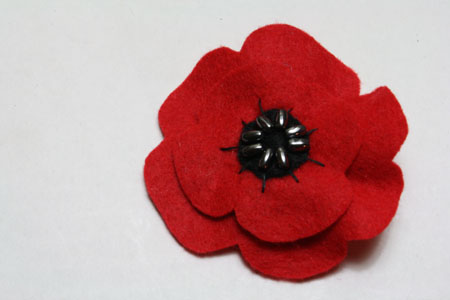


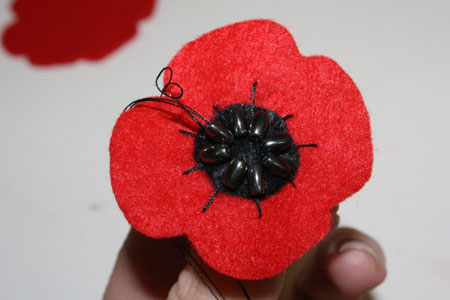
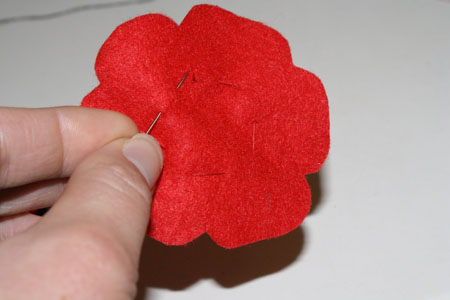
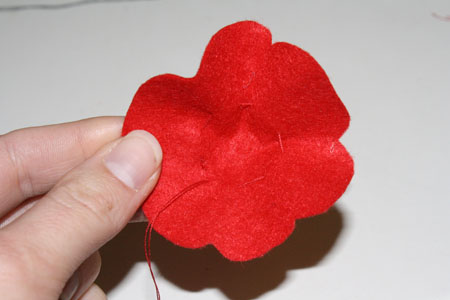
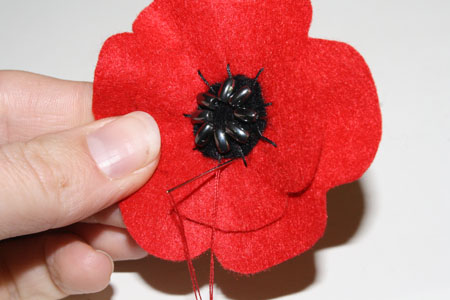
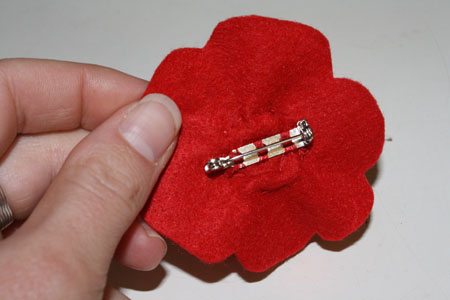
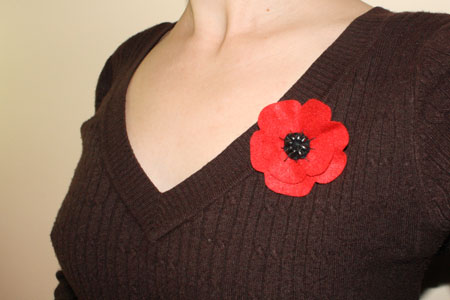
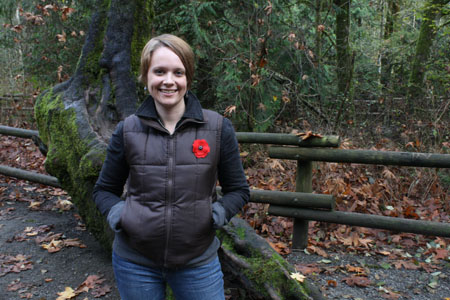
Erin
/ October 16, 2015Thank you! These poppies are perfect. What a beautiful way to reinforce Remembrance Day and help next generations understand and remember. As a teacher, I’m always looking for quick and easy crafts to bring into my classroom. I’ll adapt it a little to simplify it but my grade 4,5 & 6 students will be making them in class this year.
Lori Garvey
/ November 9, 2015Thanks for the pattern. My Mom and I used to buy paper poppies that were sold by the VFW (USA) on Veteran’s Day. Sadly I have not seen any paper poppies sold in many years. I made a bunch of your poppies while watching TV last night. I am proudly wearing one today and will stop off at my parents house tonight to give them poppies. My Dad served 22 years in US Navy. My Paternal Grandfather fought in for the US in WWI France and my maternal Grandfather fought on the Russian Front (ok that side was for Germany during WWI).
Love the poppies- thanks for preserving the tradition- Thank you Canada on Remembrance Day.
Marina
/ January 7, 2017Canada will be celebrating their 150 Birthday and the Royal Canadian Legion will be celebrating 100th anniversary of Vimy Ridge. As a member of the Royal Canadian Legion my plan is to make your poppy which in turn will be assembled as a wreath to be placed on our monument Nov 11th/17 on behalf of our Branch. Thank you in advance for the perfect poppy and instructions.
Ava Walter
/ October 17, 2017Thank you for this simple pattern. We are trying to make quilt blocks with a poppy on each block to remember each of the veterans from our branch. The finished quilt panels will be hung in our hall forever.
Their names will not be forgotten.
Trend EA for MT4
/ January 26, 2018I was studying some of your articles on this internet site and I think this web site is real informative! Continue putting up.
Trend EA for MT4 http://robotfx.ro/post/135436955967/robotfx-fluid
Mary Margaret Pike
/ October 27, 2018We also wear them on Heart Health for Women Day.
hk, Sydney
/ April 20, 2020Thank you so much for a wonderful poppy tutorial. In Australia we also learn ‘In Flanders Fields’ at school, and ANZAC Day (honouring the Gallipoli landings on April 25, along with our NZ brothers-in-arms) is really our “national day” in the way that the official Australia Day can never be.
Janet
/ October 25, 2020In Britain almost everyone wears a poppy in November.